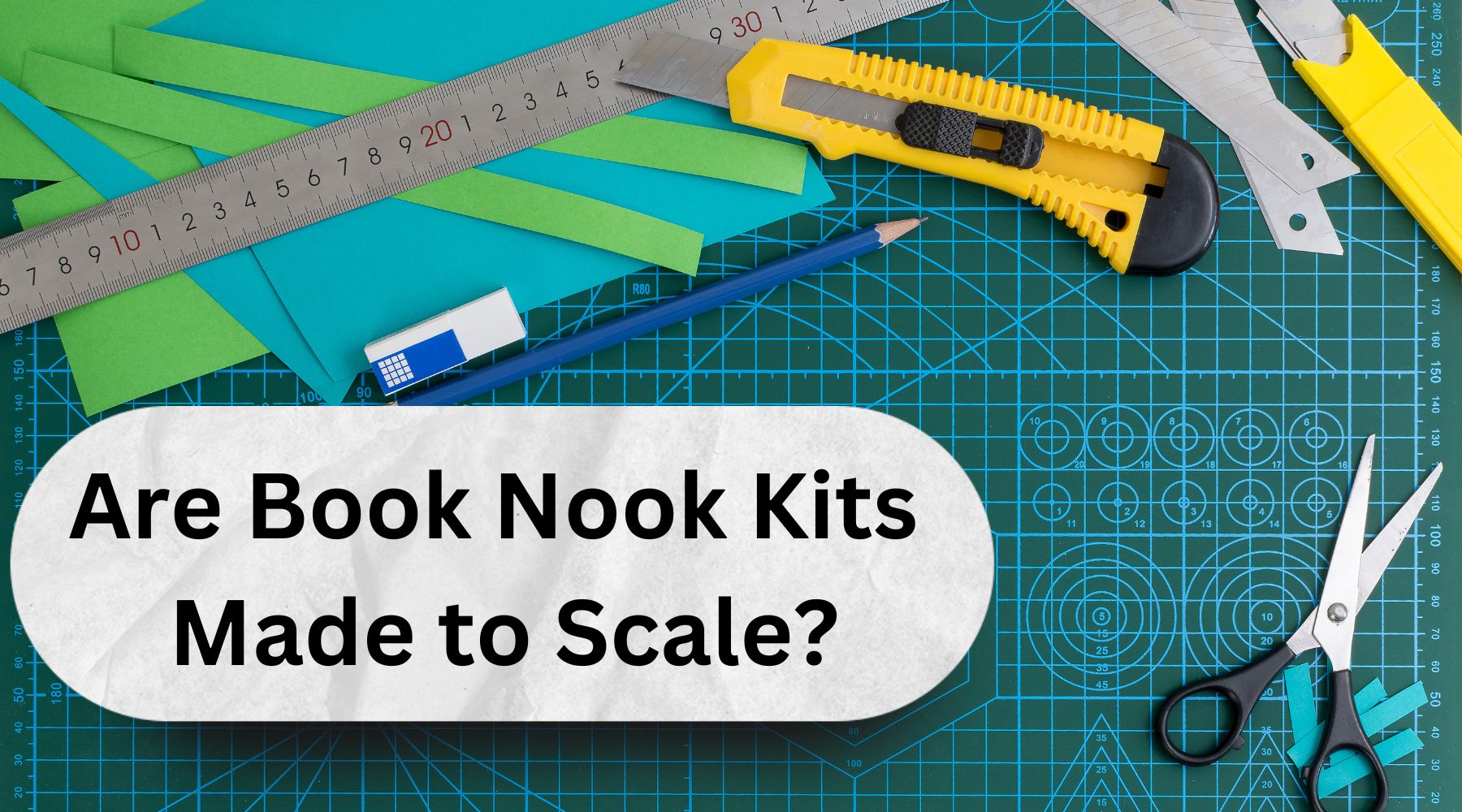Book nooks may look like realistic miniatures of a non-fictional scene, but that’s by design and not necessarily the scale model concept that’s used in architecture. As a hobby, precision doesn’t matter. The only thing that matters is that the scene portrays what you have in mind. Scale ratios can help you do that. Miniature models of dioramas and many more types of model kits are built to scale, but book nook kits aren’t. The size of the model is always around the height of a book and then the scene within the book is made to look realistic.
Scale fits into book nook designs, but only in general terms. The vast majority of book nooks are suited to miniature accessories of 1:12 or 1:24. That isn’t a rule though and you can change things up to make it look entirely fictitious or create a realistic-looking book nook. By incorporating scale model concepts into your book nook design, realistic perspectives are emphasized.
Understanding Scale in Miniature Model Kits

The scale number is a ratio used to show the difference between the real size (size in real life) of an object and the miniature version. The simplest example is a 1:1 ratio, meaning the scale is full-size - 1 is the whole unit and is equal to 1 inch, foot, or meter. In scale models, the 1 represents a unit of measurement (inch, foot, or meter). The second number in the ratio is the fraction of a whole unit. To illustrate: 1:12 means 1 is the whole unit, the 12 is the 12th of the measurement. Scale ratios mostly suited to book nook accessories are typically 1:12 and 1:24. Those aren’t the only ones though. Some book nook kits indicate that they use a “quarter scale”. In imperial scale measurements, a quarter scale means a quarter inch is representative of 1 foot.
In terms of sizes the scale ratios reflect, the larger the second number, the smaller the piece. Animals at 1:32 like a miniature terrier dog could be 1cm in height. Trees at a 1:87 scale may measure 7cm in height. In that respect, putting a dog beside a tree in the diorama at those ratios, you’d have a tree 7 times the height of a dog. Among mature woodland, that could look realistic, which is why book nooks aren’t built to any particular scale. If it feels right, go with it. It’s a creative process.
The Advantages of Building Book Nooks with Scale Ratios in Mind

A benefit to using scale ratios as reference guides when designing book nooks is to make your scene believable. To use an illustrative example, a reading lamp that sits below the height of a chair would stand out. You’d want the lamp to be at least at the same height as the reading chair or higher to give the interior perspective of scale. To customize a Japanese-themed book nook kit, you could research the history of lighting and learn that Japanese table lanterns (Ariake-Andon) measured 300 x 230 x 232 mm. (Similar to the light shown in the picture above). Knowing that the general scale used for your book nook kit was 1:12, you could make a lantern 10x smaller (a scale of 1:10) to have a 30 x 23 x 23.2mm cube lantern sat on a side table. That’s where the advantage of scales comes in. Without using the same ratio across the scene, you could wind up with an Andon that’s more like a floor lamp towering to ceiling height in a book nook.
Miniature Models vs Scale Models
In the world of miniature model collecting, the two terms you’ll come across are ‘miniature models’ and ‘scale models’. Both are different and it’s important to know that difference. Miniature figurines are sold individually and usually provide a scale ratio to give you an indication of how it’s been miniaturized. A 1:72 figure will be 72 times smaller than the realistic size. 6ft in mm is 1828.8. Divide that by 72 (1:72) and you’d get 25.4mm making that the height of the figurine. Scale models refer to a collection (or a kit) used to create a scene meaning everything is curated to a standard scale making it look realistic.
Examples of miniature models across different genres

If you’re looking for parts to customize a book nook kit or make a DIY book nook from scratch, there are numerous specialist suppliers you can use. From terrain building stockists, model railways, warcraft figurines, dollhouse miniatures, etc. If there’s a cumulated interest in building model kits, there are makers designing parts to furnish them. All will have different scales.
- 1:12, 1:18, and 1:24 are common among action figurines and miniature doll house accessories.
- Model railways use a few. N gauge is 1:160 scale or 1:148 in the case of the British N gauge. The TT gauge is 1:120. In the U.S. 0 gauge is a 1:43.5 scale and half 0 (H0) gauge is half as small using the 1:87 scale. Model railway suppliers have more than trains and tracks. There are model buildings, terrain, trees, figures, and farm animals available for the scenery.
- For larger accessories like ships, trains, and skyscrapers to fit inside a book nook, you may need to go into the tiny scale territory, which is generally fractions to the thousandth such as 1:1300 and 1:1400.
As an example of tiny scaling, if you were to include a super skyscraper (984 ft), you’d need to make that tiny. 1:1400 scale can do that. 984 ft in mm is 299,923 mm. Divide that by 1400 and you get 214.33. A scale model miniature of a super skyscraper at 1:1400 would be 21.4cm. The downside of course is that to keep the building appearing as tall, you’d need to scale down the accessories such as figures on the sidewalk walking past. If they were 15cm, the super skyscraper wouldn’t appear nearly as tall. That’s an advantage of buying quality book nook kits. Calculations will have been done, and all the accessories included will be representative of a particular scale so as they make the scene believable. Even sci-fi book nook kits for a fantasy décor vibe can be made to have scenes that look like they could be real in a far-off land by building the design and accessories to a single scale.




Share:
7 Travel-Themed Ideas for a Perfect Date-Night In
Best Gifts for International Travel Lovers